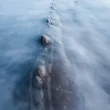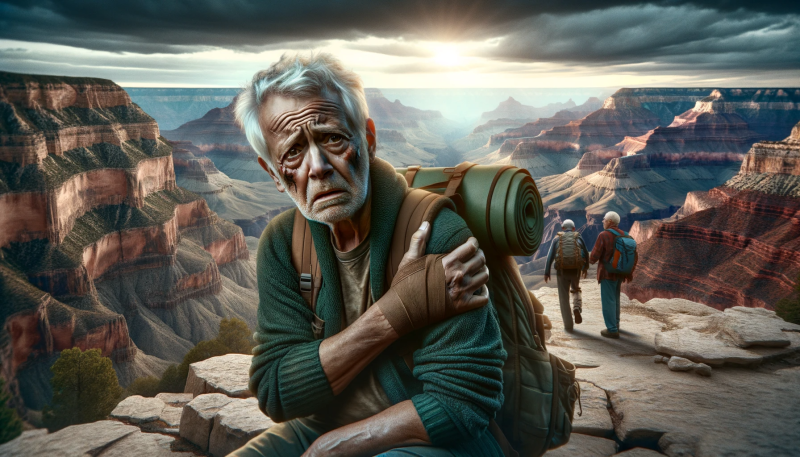You’ve likely often heard that you should be picky when choosing your friends. However, one hiker learned this lesson the hard way.
The adventurer experienced an injury in one of the world’s most challenging environments. Despite the seriousness of the situation, their hiking pals continued their adventure and left him to fend for himself.
Today, we’ll examine the mistakes made by the group and what they should have done differently. We’ll even dive into some safety tips for hiking in the Grand Canyon.
Let’s hit the trail!
Hiker Abandoned By Friends in Grand Canyon
The Mohave County Sheriff’s Office sprung into action when it received an emergency alert from an Apple device. The location was near Kanab Creek, which is in the Grand Canyon. They take these calls very seriously because of the rough and rugged terrain.
They were able to locate the 63-year-old male responsible for sending the alert when they arrived on the scene. He had fallen and severely injured his shoulder.
The hiker admitted to starting the hike at the North Rim with four friends, but they all left him behind to get help.
It’s important to note that the group was three or so days into a week-long adventure. Even if he were healthy, it wouldn’t be easy to make the return trip.
Luckily, the situation turned out fine, and the man got the help he needed.
What Should They Have Done?
You may have heard that hindsight is 20/20, which means it’s easier to look back on a situation and know what to do or how to respond. Unfortunately, this group of explorers made some serious mistakes that could have resulted in a tragedy.
When hiking, whether in the Grand Canyon or a less adventurous location, you should never leave someone behind who’s injured.
The responsible thing to do would have been for the group to call for help and wait with the man until the rescuers arrived. They then could have continued after confirming their buddy got the help he needed.
Luckily, as far as we know, the story has a happy ending. There was no report of any other additional issues.
Safety Tips for Hiking in the Grand Canyon
Hiking in the Grand Canyon is incredibly dangerous. It’s easy to bite off more than you can chew. You could be one of the hundreds of search-and-rescue efforts that take place there each year. Let’s look at some safety tips for anyone planning to hike in the Grand Canyon.
Plan and Prepare
Depending on the trail, it’s typically a seven- to 10-mile hike to the bottom of the Grand Canyon. While you may have hiked this distance many times before, this isn’t an ordinary hike. For many, reaching the bottom takes four to five hours. Hiking in the Grand Canyon requires a solid plan and months of preparation.
Once you reach the bottom, you may need to turn around and do it all over again. However, this time, you’ll be going uphill instead of down. This means conquering the 4,500- to 6,000-foot increase in elevation, which is a challenging task.
Planning and preparation are essential if you’re going to be successful. You can’t afford to rush either of these. If you do, you’ll quickly discover you’re over your head once you lace up your boots and hit the trail.
Get Required Permits
You won’t need a permit for day hiking in the Grand Canyon. However, many people hike to the bottom of the canyon and spend a night or two exploring. Overnight camping in the Grand Canyon requires a permit, and rangers frequently check for them.
Typically, they’ll start asking to see permits later in the day. They want to ensure that anyone without a permit has plenty of daylight hours to hike out of the canyon safely. Luckily, you can avoid this nightmare by securing a permit.
Stay Hydrated
One of the most important things you should do on any hiking trip is bring water. The size of your water supply significantly depends on how far you plan to go. In addition, you need to consider whether or not there’s access to potable water along the way.
During the summer, temperatures regularly reach triple digits at the Grand Canyon. You should be drinking water throughout the day. If you wait until you’re thirsty to drink, it’s too late. You can quickly become dehydrated, which can cause many issues.
When hiking in a group, ensure everyone has plenty of water before starting. You don’t want to hit the trail and discover that someone is unprepared. They’ll need water, and the rest of your group must sacrifice some of their supplies to accommodate anyone unprepared.

Protect Yourself from the Sun
It won’t take long for you to start to feel the effects of the sun. During summer, sunburns can begin to occur within minutes. However, they can happen any time of year if you don’t take the proper precautions.
To keep yourself safe, you must invest in sunscreen with an SPF (Sun Protection Factor) of at least 30. Ensure you cover your face, neck, arms, legs, and other exposed skin. You also can’t forget to reapply every two to three hours, especially if you’re sweating.
In addition to sunscreen, wear protective clothing that is lightweight, loose-fitting, and covers as much skin as possible. The best options are dri-fit clothing, which dries quickly and absorbs sweat.
Investing in a solid pair of sunglasses is also a good idea. These can help protect your eyes from harmful rays from the sun. You’ll be much more comfortable and able to see better while navigating the trail.
Wear Proper Footwear
The terrain in the Grand Canyon can be incredibly challenging. As a result, you’ll want a sturdy pair of hiking boots or trail shoes. Look for a pair with plenty of stability and ankle support when shopping. The last thing you want is to injure your ankle while hiking in the Grand Canyon.
Other features you want to look for are their comfort, traction, and waterproofing. Since you won’t know exactly what terrains you’ll be conquering, it’s best to prepare for anything.
However, make sure to break them in before the hike. If not, you could develop blisters and suffer extreme pain during the adventure.

Start Early
Start as early as possible to avoid the heat and crowds. Many hikers will begin just before or right at sunrise. This way, they can log several miles before the sun starts to warm things up. The cooler temperatures can help you avoid dehydration and make the experience more enjoyable.
Some of the trails at the Grand Canyon can get very busy. Starting early allows you to enjoy the viewpoints and rest areas with minimal amounts of other hikers. Sitting in silence for a few minutes can be relaxing. It can provide an opportunity to connect with nature during the trip.
HOT TIP
Do you remember the 2010 campervan challenge? It was unbelievable!
Know Your Limits
A mistake many people make when hiking in and around the Grand Canyon is not knowing their limits. The South Rim of the Grand Canyon sits at an elevation of around 7,000 feet, while the north rim is approximately 8,000. These can make it harder to breathe and perform routine physical activities.
In addition to the increased elevation, hiking here typically requires going up and down steep elevation changes. These factors can create a hazardous situation if you’re not careful.
Be honest with yourself and assess your physical and mental condition. While hiking from one rim to another may sound exciting, it’s incredibly challenging.
The last thing you want to do is take on a challenge that is too much for you. If you do, you could end up requiring assistance from rescuers. Save yourself and the rescuers the trouble, and know your limits before hitting any trail.

Choose Your Fellow Hikers Wisely
Hiking can be a great way to spend time in nature and bond with friends and family. Additionally, as this hiker has shown us, it can also be an opportunity to see who your real friends are. There’s no excuse for leaving someone behind because they’re injured, especially in a remote and dangerous location like the Grand Canyon.
Choose your hiking partners wisely if you plan an epic hiking adventure like the Grand Canyon. Think carefully about whether you can trust them to have your back if things don’t go as planned.
Do you have any other tips for hiking the Grand Canyon?










